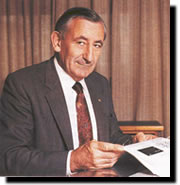
Edward F Sandbach (1975-1985)
 |
Ed Sandbach joined the then Postmaster General's (PMG) Department as a Clerk in 1941. Subsequently graduating as a Bachelor of Science with honours in Physics and Radiophysics from Melbourne University, he joined the Radio Section of the Department's Research Laboratories as an acting Engineer in 1943, where he participated in early investigations of time division multiplexed, pulse operated microwave radio systems. |
Following a period of further study as a Cadet Engineer, Ed gained his Bachelor of Arts degree from Melbourne University, majoring in mathematics, before he re-joined the Laboratories as an Engineer engaged on VHF and UHF multi-channel radio system developments.
In 1948, Ed was placed in charge of the Time and Frequency Standards Division of the Laboratories. Over the next 15 years, he was responsible for a number of important developments of the PMG Department's reference frequency standards and associated equipment facilities. These developments included the design and commissioning of new standards built around high precision 100 kHz ring crystals, the introduction of the Speaking Clock Service, the development of VLF phase tracking techniques for precise inter-continental frequency comparisons, experiments with an ammonia MASER, the introduction of standard frequency and time broadcasts from Radio Australia's site at Lyndhurst, Victoria, and early investigations of caesium atomic clocks offering a hundredfold improvement in their frequency stability.
During 1964, Mr Sandbach was promoted to the position of Assistant Director-General in charge of the Apparatus and Services Branch of the Laboratories. In this position, he was responsible for the Laboratories' functions relating to the physical sciences, reference standards and laboratory services and facilities. In a later re-organisation of the Laboratories, the Branch was re-named the Applied Science and Laboratory Services Branch. Whilst in this position, Ed played a key role in the re-establishment of the Laboratories in new, much-improved buildings at Clayton.
During 1967, Ed completed the advanced management course at the Australian Administrative Staff College.
With further growth and re-organisation of the Laboratories, the physical sciences functions were separated and given Branch status, and Mr Sandbach continued to fulfil the responsibilities of Assistant Director, Standards and Laboratories Engineering, until mid-1975, when the PMG's Department was dissolved and the Australian Telecommunications Commission (less formally known as Telecom Australia) was established on 1 July 1975. On this date, Ed succeeded to the position of Director, Research, responsible to the Chief General Manager for all R&D functions performed by the Research Department of the newly formed Commission. Mr Sandbach occupied this position until he retired.
During his career, Ed made significant contributions not only to the operations of the PMG's Department and Telecom Australia in the development of the Australian national telecommunications network but also to the operations of national and international standards organisations, research organisations and academia.
With the development of satellite communication techniques, Ed, in conjunction with Mr E. R. Craig, was extensively involved in the activities of CCIR Study Group IV (Space Systems and Radio Astronomy) from 1962. For several years, he joined with personnel of OTC (Australia) to represent Australia at Intelsat Conferences. He led the Australian delegations to CCIR Plenary Assemblies in 1966, 1970 and 1974. He participated in the ITU Administrative Space Conferences in 1963 and 1971, and the Plenipotentiary Conferences in 1973 and 1982.
For many years, Mr Sandbach contributed to the activities of several technical committees of the Standards Association of Australia (SAA). He was Telecom Australia's representative on the Council and the Executive Board of the Council of the SAA. He was also a member, and Chairman, of the SAA Telecommunications and Electronics Standards Board and its Executive, and of the Australian Electrotechnical Committee of SAA. Another position related to measurement activities also held by Mr Sandbach included chairmanship of the Electrical Registration Advisory Committee of the National Association of Testing Authorities (NATA).
Mr Sandbach was Telecom Australia's representative on the Radio Research Board, chairing the Board from 1981 to 1984. He was a member of the Victorian State Committee of CSIRO and a Fellow of the Australian Academy of Technological Sciences.
In 1981, Ed's distinguished career in the service of the Australian public was recognised by an award in the Queen's Birthday honours, whereby he was admitted to membership of the Order of Australia (General Division).
On 23 January 1985, Ed Sandbach retired from the position of Director, Research, after a lifetime and distinguished career in telecommunications. Throughout his career, Ed's professional and thorough approach has been a common hallmark of his many contributions to the advancement of telecommunications, both in Australia and in international forums where Ed represented Australian interests.
Mr Sandbach was equally respected for his contribution to the community. He was a Director of the Victorian Section of the Royal Flying Doctor Service for 13 years from 1986 to 1999 and received an inaugural John Flynn Award in 2000. Mr Sandbach, a family man, was also the Branch Commissioner for Victoria of the Rover Scouts, Scouts Australia for 10 years and an Elder of the Presbyterian and then Uniting Church for 42 years.
Ed Sandbach passed away on 5th February, 2003.
Last updated: 14 February 2003